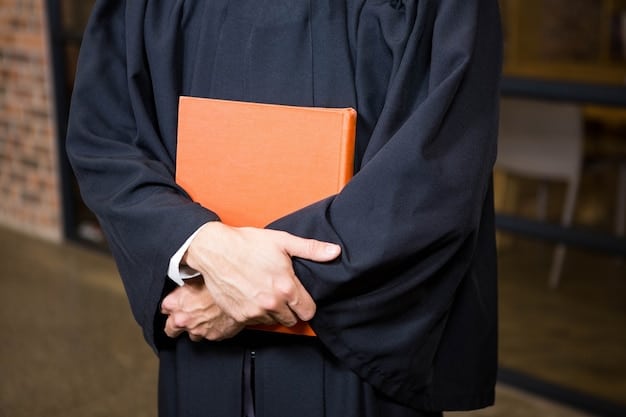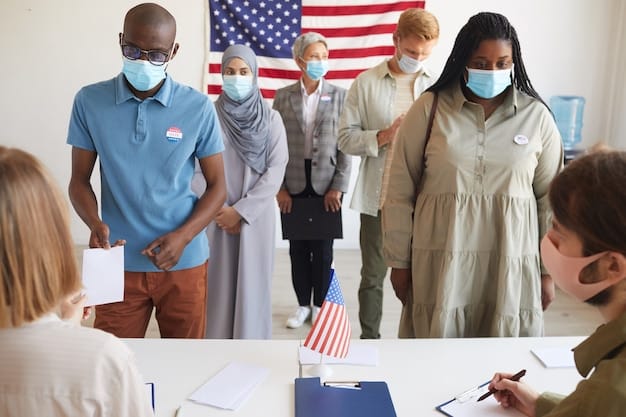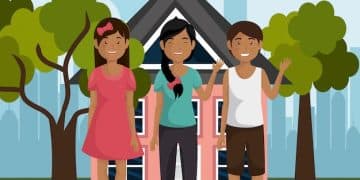Federal Student Loan Forgiveness Programs: Eligibility and Application Process

Federal Student Loan Forgiveness Programs offer eligible borrowers a pathway to have their remaining student loan balance canceled after meeting specific work or service requirements and fulfilling all necessary qualifications.
Navigating the complex world of student loans can be overwhelming, but understanding
Federal Student Loan Forgiveness Programs: Eligibility and Application Process can significantly ease the burden for many borrowers, offering a chance to have their remaining debt forgiven.
Understanding Federal Student Loan Forgiveness Programs
Federal student loan forgiveness programs provide opportunities for borrowers who meet certain criteria to have all or a portion of their federal student loan debt canceled. These programs are typically tied to specific professions or types of employment, offering a significant benefit to those who dedicate their careers to public service or other qualifying fields.

Types of Federal Student Loan Forgiveness Programs
There are different types of forgiveness programs, and eligibility varies widely. Understanding the specifics of each can help you determine which program is right for you.
- Public Service Loan Forgiveness (PSLF): This program is for borrowers employed by a U.S. federal, state, local, or tribal government or a non-profit organization.
- Teacher Loan Forgiveness: Available to qualified teachers who teach full-time for five consecutive years in a low-income elementary or secondary school.
- Income-Driven Repayment (IDR) Forgiveness: After 20 or 25 years of qualifying payments under an income-driven repayment plan, the remaining balance is forgiven.
Each program has unique requirements that must be met to qualify. It’s essential to review these requirements carefully to ensure compliance.
By providing targeted relief to borrowers in specific sectors, these programs not only alleviate individual financial burdens but also help attract and retain talent in critical public service roles.
Eligibility Criteria for Federal Student Loan Forgiveness
Eligibility for federal student loan forgiveness programs depends on various factors, including the type of loan, employment, and repayment plan. Meeting these criteria is essential for participating in and benefiting from these programs.
Qualifying Loans
Not all federal student loans are eligible for every forgiveness program. Generally, loans made under the Direct Loan Program are the most widely eligible. However, there are ways to consolidate other types of federal loans to qualify.
- Direct Loans: Generally eligible for all federal loan forgiveness programs.
- Federal Family Education Loan (FFEL) Program Loans: May be eligible for PSLF if consolidated into a Direct Loan.
- Perkins Loans: May be eligible for PSLF if consolidated into a Direct Loan.
It’s crucial to understand the type of loan you have and its eligibility for different forgiveness programs before proceeding with the application process.

Qualifying Employment
Employment requirements vary by program. PSLF, for example, requires full-time employment with a qualifying employer. Teacher Loan Forgiveness requires teaching at a qualifying low-income school.
Understanding the specific employment requirements for each program is crucial. Borrowers should verify that their employer qualifies for PSLF and that their teaching position meets the criteria for Teacher Loan Forgiveness.
By ensuring you meet the employment eligibility, you can increase your chances of successful application and eventual loan forgiveness.
Public Service Loan Forgiveness (PSLF): A Detailed Overview
The Public Service Loan Forgiveness (PSLF) program is designed to forgive the remaining balance on Direct Loans after 120 qualifying payments are made while working full-time for a qualifying employer. This program provides substantial relief for those committed to public service.
Qualifying Employers for PSLF
To qualify for PSLF, you must be employed by a U.S. federal, state, local, or tribal government or a non-profit organization. The employer’s tax status is a key factor in determining eligibility.
Examples of qualifying employers include public schools and universities, government agencies, and 501(c)(3) non-profit organizations. However, not all non-profit organizations qualify, so it’s essential to verify the employer’s eligibility.
Making Qualifying Payments
Qualifying payments are those made under a qualifying repayment plan, such as an income-driven repayment plan. The payment must be made in full and on time to count toward the required 120 payments.
- Income-Driven Repayment Plans: These plans adjust your monthly payment based on your income and family size.
- Standard Repayment Plan: Only payments made under the 10-year standard repayment plan qualify.
- Consolidation: Consolidating loans can help you become eligible for PSLF, but it’s important to understand the implications.
Ensuring that payments are made under a qualifying repayment plan and while employed by a qualifying employer is crucial for PSLF eligibility. Borrowers should regularly certify their employment to track progress.
The PSLF program represents a significant incentive for professionals to pursue careers in public service, offering financial security in exchange for their dedication to serving the community.
Teacher Loan Forgiveness: Supporting Educators
The Teacher Loan Forgiveness program offers up to $17,500 in loan forgiveness to qualified teachers who teach full-time for five consecutive years in a designated low-income elementary or secondary school. This program acknowledges the critical role teachers play in underserved communities.
Eligibility Requirements for Teachers
To qualify for Teacher Loan Forgiveness, teachers must meet certain eligibility requirements related to their teaching position and the type of subjects they teach. Understanding these requirements is essential for determining eligibility.
Teachers must have been employed as a full-time teacher for five complete and consecutive academic years at a qualifying low-income school. Certain highly qualified teachers may be eligible for up to $17,500 in forgiveness, while others may be eligible for up to $5,000.
Qualifying Schools
Qualifying schools are those listed in the Department of Education’s Annual Directory of Designated Low-Income Schools. This directory is updated yearly and provides a list of schools that meet the poverty criteria.
Teachers should consult the directory to ensure that their school qualifies for the program. The directory is available on the Department of Education’s website.
By targeting loan forgiveness to teachers in low-income schools, this program helps to attract and retain qualified educators in communities that need them most.
Income-Driven Repayment (IDR) Forgiveness: Long-Term Relief
Income-Driven Repayment (IDR) plans offer long-term relief by forgiving the remaining balance on federal student loans after 20 or 25 years of qualifying payments. These plans are designed to make loan payments more affordable based on income and family size.
Types of IDR Plans
There are several types of IDR plans, each with its own eligibility requirements and formula for calculating monthly payments. The most common IDR plans include:
- Income-Based Repayment (IBR): Caps monthly payments at a percentage of discretionary income.
- Pay As You Earn (PAYE): Caps monthly payments at 10% of discretionary income.
- Revised Pay As You Earn (REPAYE): Similar to PAYE but includes spousal income.
Choosing the right IDR plan depends on individual circumstances, including income, family size, and loan balance. Borrowers should carefully compare the different plans to determine which one is most suitable for their needs.
Qualifying Payments and Terms
Qualifying payments must be made under an IDR plan. After 20 or 25 years of qualifying payments, the remaining balance is forgiven. The specific term depends on the plan and the type of loans.
For undergraduate loans, forgiveness typically occurs after 20 years of qualifying payments. For graduate loans, the term is usually 25 years. It’s important to keep accurate records of payments to track progress toward forgiveness.
IDR plans provide a safety net for borrowers who struggle to afford their loan payments, offering a path to eventual forgiveness and financial stability.
Navigating the Application Process
Applying for federal student loan forgiveness programs requires careful attention to detail and adherence to specific procedures. Understanding the application process can help borrowers avoid common mistakes and increase their chances of approval.
Step-by-Step Guide to Applying
The application process generally involves several steps, including completing the appropriate forms, providing documentation, and submitting the application to the loan servicer or the Department of Education.
- Research and Identify Eligible Programs: Determine which forgiveness programs you are eligible for based on your employment, loan type, and repayment plan.
- Gather Required Documentation: Collect all necessary documents, such as employment verification forms, loan statements, and tax returns.
- Complete the Application: Fill out the application forms accurately and completely.
- Submit the Application: Submit the application to the appropriate loan servicer or the Department of Education.
- Follow Up: Follow up to confirm receipt of the application and track its progress.
Accurately completing and submitting the application is crucial. Borrowers should carefully review all instructions and seek assistance if needed.
By taking a systematic approach to the application process, borrowers can navigate the complexities of federal student loan forgiveness and take a significant step toward financial freedom.
| Key Point | Brief Description |
|---|---|
| ✅ PSLF Eligibility | Employed by government or non-profit; 120 qualifying payments required. |
| 👨🏫 Teacher Loan Forgiveness | Teach full-time in a low-income school for five years; up to $17,500 forgiven. |
| 📅 IDR Forgiveness | Remaining balance forgiven after 20-25 years of income-driven payments. |
| 📝 Application Steps | Research, gather documents, complete forms, submit, and follow up on the application. |
FAQ
▼
The Public Service Loan Forgiveness (PSLF) program forgives the remaining balance on your Direct Loans after you have made 120 qualifying monthly payments while working full-time for a qualifying employer.
▼
A qualifying employer for PSLF includes U.S. federal, state, local, or tribal government organizations, as well as not-for-profit organizations that are tax-exempt under Section 501(c)(3) of the Internal Revenue Code.
▼
The Teacher Loan Forgiveness program offers up to $17,500 in loan forgiveness to qualified teachers who teach full-time for five consecutive years in a low-income elementary or secondary school.
▼
IDR plans are designed to make your student loan payments more affordable by basing your monthly payment amount on your income and family size. After 20 or 25 years, the remaining balance is forgiven.
▼
To apply for a forgiveness program, research eligibility requirements, gather necessary documents (like employment verification), complete the application form accurately, submit it to the correct servicer, and follow up on its status.
Conclusion
Understanding and navigating Federal Student Loan Forgiveness Programs: Eligibility and Application Process can significantly benefit eligible borrowers, offering a pathway to financial relief and stability, whether through public service, teaching, or income-driven repayment plans. By carefully reviewing the requirements and following the application process, you can take a proactive step towards managing your student loan debt.





